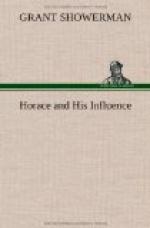What this meant in terms of actual acquaintance with the poet would not be clear without evidence of other kinds. By the end of the sixth century, knowledge of Horace was already vague. He was not read in Africa, Spain, or Gaul. Read in Italy up to Charlemagne’s time, a hundred years later his works are not to be found in the catalogue of Bobbio, one of the greatest seats of learning. What the general attitude of the Church’s leadership toward him was, may be conjectured from the declaration of Gregory the Great against all beauty in writing. Its general capacity for Horace may perhaps be surmised also from the confession of the Pope’s contemporary, Gregory of Tours, that he is unfamiliar with the ancient literary languages. The few readers of the late Empire had become fewer still. The difficult form and matter of the Odes, and their unadaptability to religious and moral use, disqualified them for the approval of all but the individual scholar or literary enthusiast. The moralities of the Epistles were more tractable, and formed the largest contribution to the Florilegia, or flower-collections, that were circulated by themselves. Horace did not contain the facile and stimulating tales of Ovid, he was not a Virgil the story-teller and almost Christian, his lines did not exercise a strong appeal to the ear, he was not an example of the rhetorical, like Lucan, his satire did not lend itself, like a Juvenal’s, to universal condemnation of paganism.
In the eighth century, Columban knows Horace, the Venerable Bede cites him four times, and Alcuin is called a Flaccus. The York catalogue of Alcuin shows the presence of most of the classic authors. Paul the Deacon, who wrote a poem in the Sapphics he learned from Horace, is declared, he says, to be like Homer, Flaccus, and Virgil, but ungratefully and ungraciously adds, “men like that I’ll compare with dogs.” In Spain, Saint Isidore of Seville knew Horace in the seventh century, though the Rule of Isidore, as of some other monastic legislators, forbade the use of pagan authors without special permission; yet the coming of the Arabs in the eighth century, and the struggle between the Gothic, Christian, and Islamic civilizations resulted, for the next six or seven centuries, in what seems total oblivion of the poet.
In the ninth and tenth centuries, under the impulse of the Carolingian favor, France, in which there is heretofore no evidence of Horace’s presence from the end of Roman times, becomes the greatest center of manuscript activity, the Bernensis and six Parisian exemplars dating from this period. Yet the indexes of St. Gall, Reichenau, and Bobbio contain the name of no work of Horace, and only Nevers and Loesch contained his complete works. The Ecbasis Captivi, an animal-epic appearing at Toul in 940, has one fifth of its verses formed out of Horace in the manner of the cento, or patchwork. At about the same time, the famous Hrosvitha of Gandersheim writes her six Christian dramas patterned after Terence, and in them uses Horace. Mention by Walter of Speyer, and interest shown by the active monastery on the Tegernsee, are of the same period. The tenth century is sometimes spoken of as the Latin Renaissance under the Ottos, the first of whom, called the Great, crowned Emperor at Rome in 962, welcomed scholars at his court and made every effort to promote learning.




